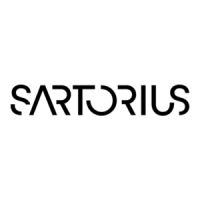Do you have a question about the Sartorius BP 6100 and is the answer not in the manual?
Guidelines for choosing a suitable location for the balance.
Instructions for connecting the balance to its electronics box.
Steps to assemble the weighing chamber with draft shields.
Steps to assemble round and rectangular weighing pans.
Notes on AC adapter safety, grounding, and RF interference.
Instructions for connecting printers or PCs to the interface port.
Advice on handling samples that cause static electricity.
Required warmup time and automatic self-test procedure.
How to turn the display on and off using the standby key.
Steps for internal calibration using the CAL key.
Instructions for external calibration using calibration weights.
Accessing calibration functions via the menu access switch.
Performing a calibration test to check accuracy.
Information about the data interface port and connecting devices.
Guidelines for cleaning the balance safely and effectively.
Checks for safe operation and when to contact service.
How to set menu codes to select specific functions.
Step-by-step guide to accessing and navigating the menu.
How to confirm and store menu code settings.
How to adjust the balance to different ambient conditions.
Selecting weighing modes for optimal adaptation.
Setting parameters for data output (print on request, auto print).
How to start or stop automatic data output.
Defining access to the balance operating menu and blocking keys.
Storing tare weight for automatic taring in applications.
Displaying and changing the reference sample quantity for counting.
Selecting manual or automatic start for animal weighing.
How to set the menu code for ISO/GLP compliant output.
Connecting devices for ISO/GLP printing or recording.
Information on connecting Sartorius balances to peripheral devices.
Electrical connection details for interface ports and cabling.
Explanation of the CE marking and its significance for product compliance.
Requirements related to the CE marking directive for equipment.
Operator responsibility for modifications and connections to equipment.
Regulations for weighing instruments used in legal metrology.
Services included in the new installation package for optimal results.
Information on subsequent verifications and their validity rules.
| Capacity | 6100 g |
|---|---|
| Readability | 0.1 g |
| Repeatability | ±0.1 g |
| Linearity | ±0.2 g |
| Pan Size | 180 mm |
| Calibration | External |
| Interface | RS-232 |
| Weighing Units | g, lb, oz |











